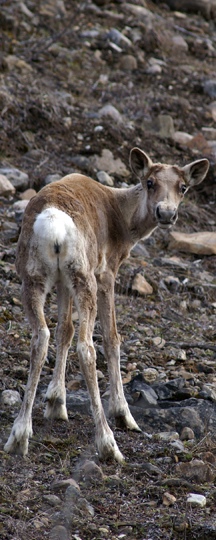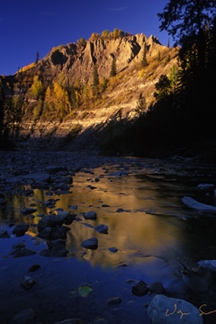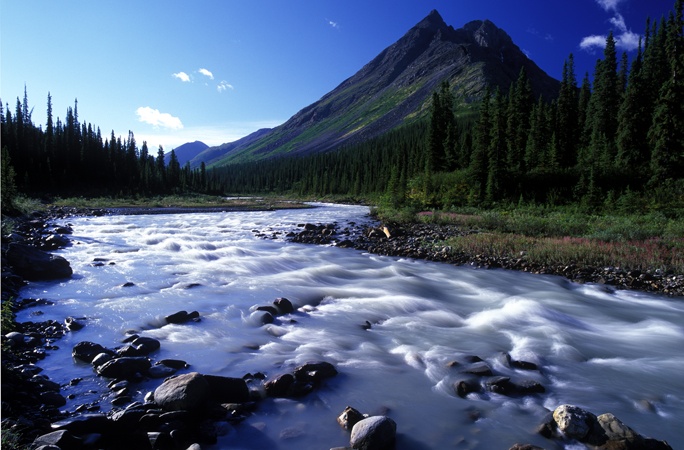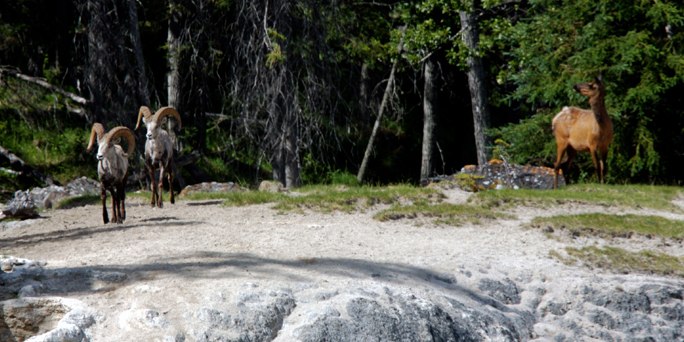

THE WILD HEART
"The Muskwa-Kechika is one of the few remaining places in the entire world where a fully-functioning wild- erness ecosystem of this complexity and value still lives and breathes as it always has."
Wayne Sawchuk
Wayne Sawchuk

RAW BEAUTY
"Few places on earth match the sig- nificance of the M-KMA in terms of raw beauty, isolation, biodiversity, wildlife, wilderness, natural resources, and spiritual and cultural values."
Muskwa-Kechika Advisory Board: 2005-06 Annual report to the Premier and public
Muskwa-Kechika Advisory Board: 2005-06 Annual report to the Premier and public
THE MUSKWA-KECHIKA

The Muskwa-Kechika Management Area (M-KMA) is located in northeastern BC and encompasses 6.4 million hectares (16 million acres) of land with varying levels of conservation, preservation and land use practices. Encompassing large areas of the Northern Rockies and Cassiar mountains, it is named after two great rivers that flow through it: the Muskwa and the Kechika. It has more species in greater abundance than anywhere else on the continent and that makes it of global importance.
The M-KMA plan was conceived in 1993 by Wayne Sawchuk and George Smith. While looking at British Columbia Ministry of Forest's Inventory of Undeveloped Watershed maps in 1992, Wayne noticed a network of fifty pristine watersheds. Miles away, George was looking at the same maps. It was not long before a productive partnership was formed.
The pair was ideally matched. Wayne had intimate knowledge of the area. He was familiar with many of the region's stakeholders because he had engaged in local logging, hunting, guiding and trapping activities for most of his life. He understood the land and the people. At that time, George was the national campaign director for Canadian Parks and Wilderness Society (CPAWS). He was used to dealing with the political arena, and knew how to garner funds. Wayne rolled up his sleeves to build community, while George found funding to map the ecological and resource values of the land.
It was perfect timing. The British Columbia government was initiating Land Resource Management Plans (LRMPs) for various areas of the province. The goal of the LRMPs was to have multi-stakeholder planning tables mutually determine how to best utilize each LRMP area. Wayne and George worked at the Fort St. John, Fort Nelson, and Mackenzie LRMPs to ensure that the the M-KMA model was considered in each table's final plan, and fortunately of the planning tables ultimately did so.
In 1998 the M-KMA Act was officially established by legislation.
The M-KMA plan was conceived in 1993 by Wayne Sawchuk and George Smith. While looking at British Columbia Ministry of Forest's Inventory of Undeveloped Watershed maps in 1992, Wayne noticed a network of fifty pristine watersheds. Miles away, George was looking at the same maps. It was not long before a productive partnership was formed.
The pair was ideally matched. Wayne had intimate knowledge of the area. He was familiar with many of the region's stakeholders because he had engaged in local logging, hunting, guiding and trapping activities for most of his life. He understood the land and the people. At that time, George was the national campaign director for Canadian Parks and Wilderness Society (CPAWS). He was used to dealing with the political arena, and knew how to garner funds. Wayne rolled up his sleeves to build community, while George found funding to map the ecological and resource values of the land.
It was perfect timing. The British Columbia government was initiating Land Resource Management Plans (LRMPs) for various areas of the province. The goal of the LRMPs was to have multi-stakeholder planning tables mutually determine how to best utilize each LRMP area. Wayne and George worked at the Fort St. John, Fort Nelson, and Mackenzie LRMPs to ensure that the the M-KMA model was considered in each table's final plan, and fortunately of the planning tables ultimately did so.
In 1998 the M-KMA Act was officially established by legislation.

A MODEL OF SUCCESS
A volunteer consensus-based advisory Board whose members represent diverse perspectives advises government on the management of the M-KMA. The Premier of the province chooses this Board. The Board works to maintain the M-KMA values, strives to keep government, industry, First Nations and other stakeholder groups well informed, and makes sustainable economic recommendations to the government.
The key to the success of the Muskwa-Kechika Advisory Board lies in collaboration with all stakeholders, enabling the M-KMA vision to work for everyone. The mission of the M-KAB is to "provide respected and trusted advice that ensures the dynamic ecosystems, wilderness, wildlife and cultural diversity of the M-KMA are maintained in perpetuity."
A number of committees operate under the direction of this Board. These committees oversee projects, such as the Joint Solutions Workshop for Mining, Well Site Evaluation and Traditional Knowledge in Land Use Planning activities. Committees and projects vary according to mutually identified needs and goals. Although the M-KMA model is a world-class leader in large-scale conservation biology, its stakeholders remain ever vigilant, as changing government policies and industrial practices perpetually challenge the future survival of the M-KMA.
The M-KMA is a model for other places on earth, proving that economic development and large, intact and predominately unroaded wilderness can co-exist through responsible resource planning and land use management practices. This world-class innovative conservation model is studied around the globe, and is hailed as a leading example of its kind.
Through the tenacious optimism and ongoing efforts of people like Wayne Sawchuk, wilderness havens like this may continue to exist for centuries to come.
The key to the success of the Muskwa-Kechika Advisory Board lies in collaboration with all stakeholders, enabling the M-KMA vision to work for everyone. The mission of the M-KAB is to "provide respected and trusted advice that ensures the dynamic ecosystems, wilderness, wildlife and cultural diversity of the M-KMA are maintained in perpetuity."
A number of committees operate under the direction of this Board. These committees oversee projects, such as the Joint Solutions Workshop for Mining, Well Site Evaluation and Traditional Knowledge in Land Use Planning activities. Committees and projects vary according to mutually identified needs and goals. Although the M-KMA model is a world-class leader in large-scale conservation biology, its stakeholders remain ever vigilant, as changing government policies and industrial practices perpetually challenge the future survival of the M-KMA.
The M-KMA is a model for other places on earth, proving that economic development and large, intact and predominately unroaded wilderness can co-exist through responsible resource planning and land use management practices. This world-class innovative conservation model is studied around the globe, and is hailed as a leading example of its kind.
Through the tenacious optimism and ongoing efforts of people like Wayne Sawchuk, wilderness havens like this may continue to exist for centuries to come.

